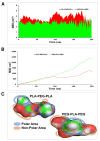Design, Synthesis, and Comparison of PLA-PEG-PLA and PEG-PLA-PEG Copolymers for Curcumin Delivery to Cancer Cells
- PMID: 37514522
- PMCID: PMC10385204
- DOI: 10.3390/polym15143133
Design, Synthesis, and Comparison of PLA-PEG-PLA and PEG-PLA-PEG Copolymers for Curcumin Delivery to Cancer Cells
Abstract
Curcumin (CUR) has potent anticancer activities, and its bioformulations, including biodegradable polymers, are increasingly able to improve CUR's solubility, stability, and delivery to cancer cells. In this study, copolymers comprising poly (L-lactide)-poly (ethylene glycol)-poly (L-lactide) (PLA-PEG-PLA) and poly (ethylene glycol)-poly (L-lactide)-poly (ethylene glycol) (PEG-PLA-PEG) were designed and synthesized to assess and compare their CUR-delivery capacity and inhibitory potency on MCF-7 breast cancer cells. Molecular dynamics simulations and free energy analysis indicated that PLA-PEG-PLA has a higher propensity to interact with the cell membrane and more negative free energy, suggesting it is the better carrier for cell membrane penetration. To characterize the copolymer synthesis, Fourier transform-infrared (FT-IR) and proton nuclear magnetic resonance (1H-NMR) were employed, copolymer size was measured using dynamic light scattering (DLS), and their surface charge was determined by zeta potential analysis. Characterization indicated that the ring-opening polymerization (ROP) reaction was optimal for synthesizing high-quality polymers. Microspheres comprising the copolymers were then synthesized successfully. Of the two formulations, PLA-PEG-PLA experimentally exhibited better results, with an initial burst release of 17.5%, followed by a slow, constant release of the encapsulated drug up to 80%. PLA-PEG-PLA-CUR showed a significant increase in cell death in MCF-7 cancer cells (IC50 = 23.01 ± 0.85 µM) based on the MTT assay. These data were consistent with gene expression studies of Bax, Bcl2, and hTERT, which showed that PLA-PEG-PLA-CUR induced apoptosis more efficiently in these cells. Through the integration of nano-informatics and in vitro approaches, our study determined that PLA-PEG-PLA-CUR is an optimal system for delivering curcumin to inhibit cancer cells.
Keywords: PEG; PLA; biomaterials; breast cancer; copolymer; curcumin; drug delivery; nano-informatics.
Conflict of interest statement
The authors declare no conflict of interest. The funders had no role in the design of the study; in the collection, analyses, or interpretation of data; in the writing of the manuscript; or in the decision to publish the results.
Figures














Similar articles
-
Graphene oxide stabilized by PLA-PEG copolymers for the controlled delivery of paclitaxel.Eur J Pharm Biopharm. 2015 Jun;93:18-26. doi: 10.1016/j.ejpb.2015.03.022. Epub 2015 Mar 24. Eur J Pharm Biopharm. 2015. PMID: 25817600
-
Folate-conjugated amphiphilic hyperbranched block copolymers based on Boltorn H40, poly(L-lactide) and poly(ethylene glycol) for tumor-targeted drug delivery.Biomaterials. 2009 Jun;30(16):3009-19. doi: 10.1016/j.biomaterials.2009.02.011. Epub 2009 Feb 27. Biomaterials. 2009. PMID: 19250665
-
Preparation and in vivo pharmacokinetics of curcumin-loaded PCL-PEG-PCL triblock copolymeric nanoparticles.Int J Nanomedicine. 2012;7:4089-98. doi: 10.2147/IJN.S33607. Epub 2012 Jul 27. Int J Nanomedicine. 2012. PMID: 22888245 Free PMC article.
-
Characteristics and cytotoxicity of folate-modified curcumin-loaded PLA-PEG micellar nano systems with various PLA:PEG ratios.Int J Pharm. 2016 Jun 30;507(1-2):32-40. doi: 10.1016/j.ijpharm.2016.05.003. Epub 2016 May 3. Int J Pharm. 2016. PMID: 27150945
-
Curcumin Delivery by Poly(Lactide)-Based Co-Polymeric Micelles: An In Vitro Anticancer Study.Pharm Res. 2016 Apr;33(4):826-41. doi: 10.1007/s11095-015-1830-z. Epub 2015 Nov 23. Pharm Res. 2016. PMID: 26597940
Cited by
-
Breaking barriers: Smart vaccine platforms for cancer immunomodulation.Cancer Commun (Lond). 2025 May;45(5):529-571. doi: 10.1002/cac2.70002. Epub 2025 Feb 3. Cancer Commun (Lond). 2025. PMID: 39901621 Free PMC article. Review.
-
Advancements in small interfering RNAs therapy for acute lymphoblastic leukemia: promising results and future perspectives.Mol Biol Rep. 2024 Jun 14;51(1):737. doi: 10.1007/s11033-024-09650-y. Mol Biol Rep. 2024. PMID: 38874790 Review.
-
Engineering Folic Acid-Modified Nanoparticles to Enhance Letrozole's Anticancer Action.Macromol Biosci. 2025 Jul;25(7):e2400558. doi: 10.1002/mabi.202400558. Epub 2025 Apr 18. Macromol Biosci. 2025. PMID: 40249348 Free PMC article.
-
Exploring Advanced CRISPR Delivery Technologies for Therapeutic Genome Editing.Small Sci. 2024 Jul 25;4(10):2400192. doi: 10.1002/smsc.202400192. eCollection 2024 Oct. Small Sci. 2024. PMID: 40212235 Free PMC article.
-
Application of Pistacia atlantica Pickering emulsion-filled chitosan gel for targeted delivery of curcumin.Food Sci Nutr. 2024 Jan 16;12(4):2809-2817. doi: 10.1002/fsn3.3962. eCollection 2024 Apr. Food Sci Nutr. 2024. PMID: 38628200 Free PMC article.
References
-
- Behl A., Chhillar A.K. Nano-Based Drug Delivery of Anticancer Chemotherapeutic Drugs Targeting Breast Cancer. Recent Pat Anticancer Drug Discov. 2023;18:325–342. - PubMed
-
- Asemaneh H.R., Rajabi L., Dabirian F., Rostami N., Derakhshan A.A., Davarnejad R. Functionalized Graphene Oxide/Polyacrylonitrile Nanofibrous Composite: Pb2+ and Cd2+ Cations Adsorption. Int. J. Eng. 2020;33:1048–1053.
LinkOut - more resources
Full Text Sources
Research Materials

